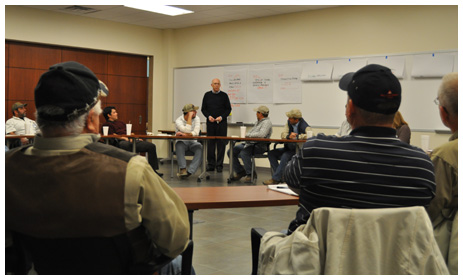 On January 12, Marek Brothers Systems Houston held a meeting to establish goals for improving and increasing their workforce. This post is a continuation of a series we are bringing to you about this extraordinary event.
On January 12, Marek Brothers Systems Houston held a meeting to establish goals for improving and increasing their workforce. This post is a continuation of a series we are bringing to you about this extraordinary event.
Marek’s Director of Workforce Development, Katrina Kersch, opened the session stating that the two objectives for the day were to prepare for the future and to improve the company’s existing workforce. She introduced Jim Kollaer who was present to lead the 24 superintendents, foremen and managers through a process to determine what 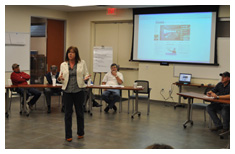 should be focused on this year and what specific action items should be taken to put everyone’s energy and resources in the right direction toward achieving the company’s five-year goals.
should be focused on this year and what specific action items should be taken to put everyone’s energy and resources in the right direction toward achieving the company’s five-year goals.
Kollaer began by reminding the group of the workforce development career ladder which is posted on the company website, stating that the goals which were about to be discussed should ultimately help all of Marek’s staff get to where they need to be on that career ladder. He stated that what was needed were goals accompanied by action items which are specific,  measurable, realistic, and time-bound. The entire group would need to be committed to each goal and to hold each other accountable to them. Kollaer set up a “parking lot” on a side board for topics that could not be agreed upon and would need further discussion at another time.
measurable, realistic, and time-bound. The entire group would need to be committed to each goal and to hold each other accountable to them. Kollaer set up a “parking lot” on a side board for topics that could not be agreed upon and would need further discussion at another time.
Prior to this meeting, Kollaer had been given the target goals which had been laid out by workforce advisory committees in previous meetings throughout the past year. He had written each of these on sheets of paper which he had folded to cover so that they could be revealed one by one for discussion. These goals included specific targets for developing a workforce proficient in the English language, increasing company productivity, increasing the percentage of training and certification within the workforce, and maintaining safety.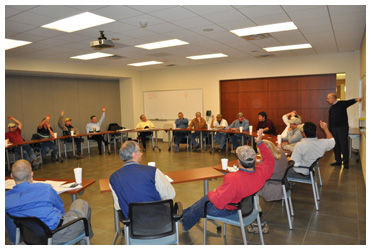 One by one each target goal was uncovered and the group was asked to define exactly what that goal meant and what actions were required to achieve it. Kollaer would add notes below the goal as it was discussed and then would ask the group to show by raised hands whether they supported each goal as it was defined. If a goal did not gain 100% support in the room, Kollaer would declare that it was no longer a goal and he would move it to the “parking lot” on the other wall. This prompted each person in the room to seriously consider whether each goal was realistic and whether it had each person’s support.
One by one each target goal was uncovered and the group was asked to define exactly what that goal meant and what actions were required to achieve it. Kollaer would add notes below the goal as it was discussed and then would ask the group to show by raised hands whether they supported each goal as it was defined. If a goal did not gain 100% support in the room, Kollaer would declare that it was no longer a goal and he would move it to the “parking lot” on the other wall. This prompted each person in the room to seriously consider whether each goal was realistic and whether it had each person’s support.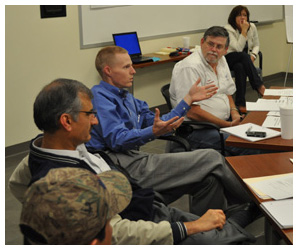 At times the discussion regarding one goal would lead the group back to re-visit a previously discussed goal. For example, initially one goal was stated that by 2015 75% of the Marek workforce must be proficient in English – which the group defined as able to read, write, and speak English. During the discussion this requirement was downsized to 75% must be able to speak English. Later, the group was talking about another goal, which was that by 2015, 75% of the Marek workforce must be NCCER certified. When it was pointed out that Marek’s training department had already decided a few years back to only administer the NCCER test in English, then it became apparent that the first goal must require English reading and writing as well as speaking in order for that same percentage of the group to become certified, which was the other goal. So the first goal was amended back to 75% must be proficient in English.
At times the discussion regarding one goal would lead the group back to re-visit a previously discussed goal. For example, initially one goal was stated that by 2015 75% of the Marek workforce must be proficient in English – which the group defined as able to read, write, and speak English. During the discussion this requirement was downsized to 75% must be able to speak English. Later, the group was talking about another goal, which was that by 2015, 75% of the Marek workforce must be NCCER certified. When it was pointed out that Marek’s training department had already decided a few years back to only administer the NCCER test in English, then it became apparent that the first goal must require English reading and writing as well as speaking in order for that same percentage of the group to become certified, which was the other goal. So the first goal was amended back to 75% must be proficient in English.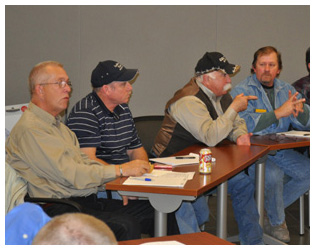 By the end of the 2-hour meeting, the group had defined 6 goals for 2015 and 4 for this year. There were a few items on the parking lot which needed further discussion and consensus before they could be included in the list. Those who were in favor of those parked items were encouraged to become champions for them and to talk to their colleagues following the meeting to convince the others. As the discussion was wrapping up, the group talked a little about what would come from the day. In the following video, Randy Hageman brings up the concern that some of the goals seem to conflict with each other, James Anderson asserts that the goals reflect where the company is trying to get to, Saied Alavi agrees that communication / English speaking is just as valuable as production, Mike Holland reminds everyone that follow-through and support of the agreed-upon goals is key, and Jim Kollaer adds that individuals in the company will respond to that kind of agreement and support and work to improve as requested.
By the end of the 2-hour meeting, the group had defined 6 goals for 2015 and 4 for this year. There were a few items on the parking lot which needed further discussion and consensus before they could be included in the list. Those who were in favor of those parked items were encouraged to become champions for them and to talk to their colleagues following the meeting to convince the others. As the discussion was wrapping up, the group talked a little about what would come from the day. In the following video, Randy Hageman brings up the concern that some of the goals seem to conflict with each other, James Anderson asserts that the goals reflect where the company is trying to get to, Saied Alavi agrees that communication / English speaking is just as valuable as production, Mike Holland reminds everyone that follow-through and support of the agreed-upon goals is key, and Jim Kollaer adds that individuals in the company will respond to that kind of agreement and support and work to improve as requested.
Mike Holland then asked the group if they believed that achieving the goals as they were set out on the board would be valuable. He asked: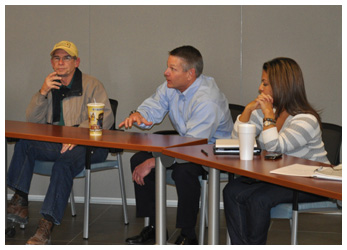 “If our workforce looked like that, would it be a better-than-average workforce? Could we make money with that workforce? We could take this profile of our workforce to a customer and say ‘we have a better workforce’. We can market this and compete with it. It’s better, not just in theory, but also in the work produced. Can you foremen supervise that workforce more efficiently? Can you communicate with them? Would our customers like that? We need to be and want to be better, and that’s how we can do it.”
“If our workforce looked like that, would it be a better-than-average workforce? Could we make money with that workforce? We could take this profile of our workforce to a customer and say ‘we have a better workforce’. We can market this and compete with it. It’s better, not just in theory, but also in the work produced. Can you foremen supervise that workforce more efficiently? Can you communicate with them? Would our customers like that? We need to be and want to be better, and that’s how we can do it.”
Interviews with post-meeting thoughts and reactions of some of the attendees will be reported soon.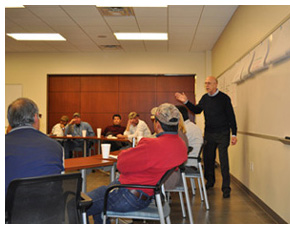
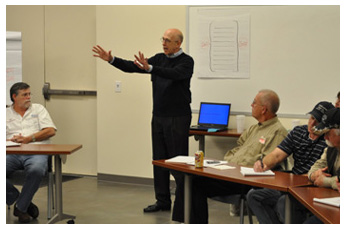
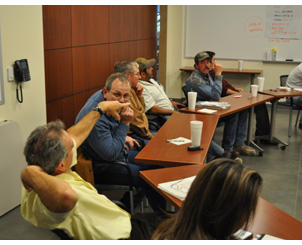
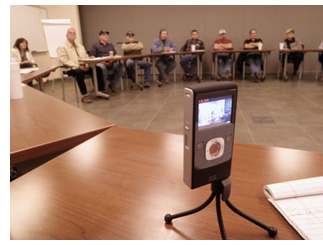
Marek Workforce Development Goal Setting Meeting
by Elizabeth McPherson | April 08, 2011



Add new comment